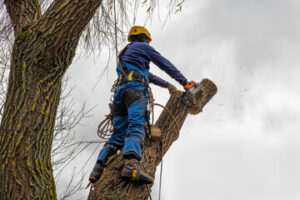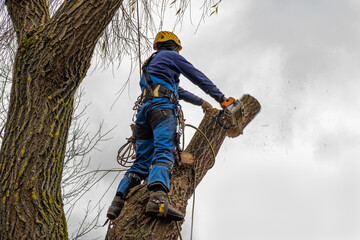When a diseased or dying tree poses safety risks or is encroaching on your home, it’s time to call the professionals for Tree Removal. Precision protects your yard from damages during the process and saves you costly repairs.
Stumps not only stifle the beauty of your landscape, they are also hazardous for children and pets who may trip or fall over them. Furthermore, rotting stumps attract insects that may spread to other trees and shrubbery in your yard, creating a pest problem that can be difficult to contain. Stump removal can help you take back your landscape and improve the overall value of your property. Visit Website to learn more.
There are several different methods for removing tree stumps, including grinding, grubbing, chemical treatments and manual digging. Which one is right for you depends on your time, budget and environmental concerns. For example, larger and more resilient stumps may require the brute force of mechanical grinding, while smaller and more compliant stumps might respond better to natural and eco-friendly alternatives.
A common option is to use a stump grinder to grind the stump down below ground level. This method is quick and effective, but it can be costly and time-consuming if you’re working with large or particularly stubborn stumps. Additionally, the process leaves behind a considerable amount of wood chips that will need to be removed.
For a more hands-on approach, you can manually dig out a stump by drilling holes around the sides of the stump and using a shovel to expose the roots underneath. Once the large roots are visible, you can use a spade to cut them away and finally remove the stump by hand. This can be a challenging task, but with patience and a good workout, it’s well worth the effort.
A more convenient alternative is to use a chemical treatment to break down the wood fibers of the stump and roots. This type of product is available at most garden centers and hardware stores, and typically contains potassium nitrate. The chemicals penetrate the stump and root system, breaking them down and making them easier to chip or crush. After applying a chemical stump killer, you should water the area frequently to ensure that the chemicals are fully absorbed.
Stump Grinding
Stumps are an eyesore, they can cause safety hazards, and lower property value. They can also be home to pests and disease, which may spread to healthy trees on your property. By removing or grinding your stumps, you can eliminate these issues.
Stump grinding involves using a special machine to grind the stump to below ground level. This is a less invasive option than complete stump removal. However, it still requires a significant investment of time and energy. Moreover, the process can leave a mess of wood chips on your lawn. It is important to choose a professional with extensive experience in stump grinding to minimize the risk of damage to your yard.
The cost of a stump grinding service depends on several factors, including the size of the stump, its location and your budget. A larger stump is more difficult to grind, and will require a larger, more expensive machine. Similarly, a stump located in a busy area will be more costly than one located in an isolated location.
When requesting a quote, it is important to note the diameter of the stump (from dirt to dirt). This measurement will be used to determine the price for your stump grinding service. It is also important to remember that the root system of a tree extends a long way below ground, so you may need to consider these areas when calculating your costs.
Whether you choose to grind a stump or remove it completely, the remnants will eventually decompose and create a natural appearance. Alternatively, you can cover the stump with soil or mulch to speed up the process. However, it is essential to speak with a reputable arborist before making this decision, as they can advise on the best course of action for your specific circumstances and provide tips on preventing regrowth.
Stump Treatment
Stumps can detract from the overall appearance of a landscape and make it difficult to mow or plant new trees. They also pose a safety hazard and are a fire risk. Plus, they can attract wood-boring insects and other pests, which then spread to surrounding trees and structures.
Stump treatments can be an effective way to kill an old stump and prevent it from resprouting. They can be applied directly to the stump or around its perimeter. If you opt for this option, be sure to follow the product manufacturer’s instructions to ensure optimal results. For example, most products require drilling holes in the stump and then applying the solution. Then, you can cover the stump with a tarp or other covering to keep rain and sprinkler water from washing away the solution.
Some gardeners are hesitant to remove old stumps because they can be a great habitat for fungi and insects, as well as provide valuable nutrients. In addition, they can serve as a base for new plants and add character to the landscape. However, old stumps can also be a tripping hazard and interfere with mowing or other yard maintenance. And, they can attract termites and other unwelcome pests.
Removing a tree stump can be a major project. It requires a lot of physical effort and the right equipment, such as a shovel, ax, and saw. It is also possible to hire a professional for this type of work, especially when dealing with larger or stubborn stumps. Stump grinding is an alternative to physical removal and involves using specialized machinery to grind the stump into wood chips. It can be more time-consuming than other methods but is highly effective, leaving your yard free of unsightly stumps and roots.
Soil Treatment
There are many different types of soil, and each has its own unique properties that affect how trees grow in it. For example, sandy soil is light and easily drains, while clay soil is heavy and holds water. Different types of soil also require different treatments to make them suitable for planting, such as chemical treatment or the addition of organic material. Soil treatment can also be used to remove contaminants from polluted soil. For instance, contaminated soils may contain petroleum hydrocarbons or pesticides, or they may be infested with metal-laden roots. In some cases, the presence of pollutants can reduce the ability of the soil to hold moisture or nutrients, making it difficult for plants to grow in it.
Tree removal has long-term effects on the surrounding ecosystem, including changes in the availability of water and nutrients to nearby plants. For example, the natural breakdown of root systems can alter how water is absorbed and distributed in the soil, which can have a positive or negative impact on nearby plants. Nutrients are also redistributed in the soil as the roots decompose, and nearby plants can either benefit from these additional nutrients or face competition for them.
A 13-year experiment comparing burn, cut, and stump removal treatments on a sagebrush steppe site characterized vegetation, ground surface conditions, and soil hydrologic characteristics at multiple spatial scales. Treatments enhanced the recovery of sagebrush steppe vegetation and promoted infiltration and limited runoff generation for intercanopy areas. However, ecological tradeoffs in vegetation and soil hydrologic responses to treatment vary among sites, management objectives, and treatments, highlighting the importance of multi-scale long-term studies of woodland encroachment and tree removal effects on sagebrush steppe landscapes.
Stump Killer
Tree stumps are a nuisance and can be difficult to remove. In addition, they can attract unwanted pests and slow the decomposition of the surrounding soil. While there are several methods for removing them, some are more effective than others. One method involves using Epsom salts to kill the stump and its roots. This is a simple and inexpensive approach to stump removal, although it does take time to work. This method is also environmentally friendly, as it doesn’t involve chemicals.
Another method involves digging around the stump and cutting major roots with a shovel or axe. Once the stump and major roots are exposed, a grinder can be used to grind it down. This is a practical and efficient option, but it may take several days to complete the process. A final alternative is to use a chemical stump killer, such as glyphosate or sodium nitrate fertilizer. While these products are safe for the soil, they may take a long time to work and can poison surrounding plants.
If you’re concerned about the environment or would like to try a more organic approach, you can speed up the decomposition of a stump by covering it with rock salt. This method works similar to the Epsom salt method but uses higher concentrations of salt. Water the stump regularly to keep it moist and covered with a tarp or plastic sheet to prevent rain from washing away the salt.
Finally, burning a stump is an option that can be adopted when other techniques aren’t feasible. However, it’s important to ensure that everything flammable is removed from the area before starting and that you have a fire extinguisher close by.


